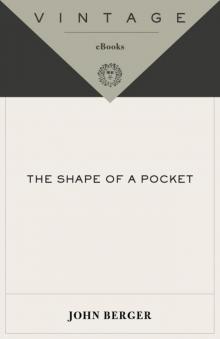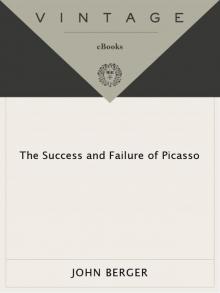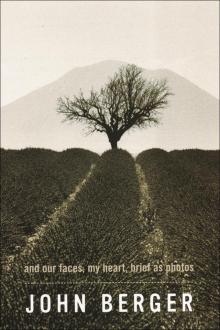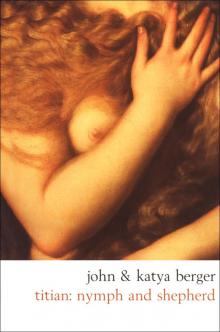- Home
- John Berger
Titian Page 2
Titian Read online
Page 2
The women in his pictures – or rather the Titian woman, with her special simplicity and innocence – is to him a relentless reminder of his artistic impotence and defeat. Him the master! Perhaps it was women who embodied the doubt you talk about? Naked, the colours of their flesh are for drowning in. Never have the painted bodies of women demanded as much as his do, to be touched, to be pressed with the hands – as Mary Magdalene presses her hand through her hair against her own breast. Yet like all other bodies in paintings across the whole world, those painted by Titian can be neither touched nor plunged into.
Gradually, he came to understand that in the very impotence of his art (this art which continually underlined the virility of the men it depicted), there might be a hidden miracle. With the sables and bristles of his brushes – instead of rendering the texture of the world’s hide – he could twist its limbs! Unable to reproduce, he could transform and transfigure. Instead of being the servant of appearances, obliged to lick their boots, he could impose his will upon them. Produce arms or hands which could never exist. Bend limbs against their nature. Fuzz objects to the point of their becoming unrecognisable. Make contours tremble so that they came to depict matter without any outline. Deny the difference between bodies and corpses. (I’m thinking of the last Pietà.)
I pack all kinds of questions concerning power, prestige, even the question of the dog, into this train of thought. The truth is that Titian’s art is itself untouchable, inviolable. It calls out and then it forbids. We remain open-mouthed.
Kisses, Katya
PARIS
Kut,
Vanitas vanitatis. In 1575, the Plague ravaged Venice, killing almost a third of the city’s inhabitants. The old man, aged nearly a hundred, died from the Plague in 1576. As did his son. After their deaths, their house on the Biri Grande, full of pictures and precious objects, was looted. And the following year, a fire in the Ducal Palace destroyed paintings by Bellini, Veronese, Tintoretto, and the old man.
I see you today, not in the Piazza San Marco, but on the terrace of your flat in Athens. In Gyzi, where all the kitchens and bedrooms overlook one another, and the washing hangs between telephone cables and hibiscus flowers. Perhaps Athens is the antipodes of Venice? Dry, makeshift, ungovernable. A city of merchants, national heroes, and the widows of heroes, where nobody dresses up.
And I’m writing in a Paris suburb, and I’ve been to the Sunday market. I saw young couples there, pale, poorly dressed against the rain, wearing jeans, hair lacquered, with city acne, holding hands, pushing prams, teasing in argot, each one with a thin, crooked-toothed recipe for happiness. And as I watched them I asked myself: What would they say about the Flaying of Marsyas? Who knows? Everyone lives legends.
In the Flaying of Marsyas, a lapdog is licking drops of blood off the ground below where Marsyas is strung up. On the right, there’s another dog, held by a boy, who is very like the one in the painting with the pups.
OK. Marsyas, the satyr-artist, entered a musical contest with the god Apollo and lost. Under the agreed conditions, the winner could do what he liked with the loser, and Apollo chose to flay the satyr alive! There are some convincing allegorical interpretations. But what interests me is why the old man chose this subject. It’s very close to what he told you in the gallery. Satyrs were, by definition, creatures who revealed how skin was like fur, and both were the outer coverings of a mystery. A kind of clothing which one couldn’t unbutton or unzip except with a killing knife.
The two men in the Marsyas canvas, with their blades and their precision (I have seen peasants skin goats with exactly the same gestures), are the precursors of Fontana and Saura, who, in our century, slashed the canvases they painted in pursuit of what lay beyond the skin of the canvas, deep in the wound.
But even after one has acepted the subject und interpreted it, one finds oneself face to face with something more startling! The scene (which in life would be an abominable scene of torture) is bathed in a light of honey and an atmosphere of elegiac fulfilment.
You find exactly the same atmosphere in the Nymph and Shepherd, painted at the same time. Yet the Nymph and Shepherd is a love scene, and in it the shepherd is playing the pipes which cost Marsyas his life!
Find the old man in Athens and ask him what he meant.
It must be the season of pomegranates.
Take care, John
ATHENS
John,
You’re right, it’s the season for pomegranates. I’m looking at one now. Split open by the centrifugal energy of its own ripeness. He would have been able to paint its vivid blood and its granular flesh – except that it’s too exotic, too eastern for him. Rather, I see for him the stone of a peach. Enlarged enormously and flattened. In fact, I see such a stone as the ground of his painting, as a kind of lining to the canvas!
Yesterday I was looking for the old man to ask him your question about why the light is so honeyed in the painting of Marsyas’ torture. Instead I found a gathering of other old men in Akadimias Street, right in the centre of Athens.
Thousands of vehicles pass there every hour of the day and night. It’s also the turn-around point of the city’s principal bus lines. It’s always crowded. It’s where I pick up my bus to go to work every day. Bus no. 222. And there, two days ago, some people, waiting to get on their bus, met their deaths.
The bus – which should have taken them home for their lunch break – went out of control and ploughed into the crowd, laying low eight people before ramming into a barrier and stopping. The victims, who were mostly students, were suffocated, the bus on top of them. Screams, blood, chaos. The police and ambulance couldn’t get through, for there were too many people. One hour later, the radio announced the victims’ names. Everybody cried and crossed themselves. A tragedy. Yet it’s the aftermath I want to tell you about, for it takes us to the heart of Greece.
When I got off my bus there yesterday (it was a bus no. 222 which caused the deaths), I saw a gathering of three or four hundred people, all men, mostly old-age pensioners – those same men go every morning to the smoky kafenios, the cafés for male clients only, to play backgammon, sip their ouzos, and comment on what’s happening in the world – rather than trying to change it. In Akadimias Street, they were waving their arms about and shouting with great excitement.
At first, I thought it must be a new meeting place for a political debate preceding the elections. But no. What these old men had come to do was to reconstitute the event. Each one had decided when he had awakened yesterday morning to make his way to the scene of the drama and try to see more clearly what had happened.
‘The girl student was there. She wanted to run when she saw the bus coming towards her, but the crowd was too dense – and there was also the bus shelter, which stopped her going in the other direction.’
‘No, you’ve understood nothing! It was the ill-fated old pensioner who must have been standing here, because they said his legs were the first to be broken! Old bones break easily’
‘I tell you, those who died were all further down there. The ones here escaped. Those over there against the barrier, they got it. The others were only wounded, and now they’re in Evangelismos Hospital. They’ll survive – thank God. Think though of the families of those who, for no reason, died yesterday at 12.15, think of them!’
And so on. A chorus straight out of Aeschylus. Or perhaps, more exactly, the agora, the future Roman forum. The market-place where everybody met to discuss the affairs of the polis.
When tourists enthuse about the living heritage of ancient Greece, it makes me a little sick. It’s too easy, too obvious. And it reminds one painfully of the political nullity into which Greek civilisation has fallen. But one thing has survived unquestionably, and that’s the national proclivity for comment. To relive happenings, to make a synthesis of them, and to draw conclusions and lessons (which are usually forgotten the next day). Greek philosophy, in its ancient sense and in its contemporary, popular sense, comes exactly from this vision
of the Chorus: to tell, to take account of the consequences, to measure the importance.
Today I passed by Akadimias Street again, I can’t avoid it. A smaller crowd of men was still there, doing the same thing. Meanwhile women had clearly come yesterday afternoon, when the men were taking their siesta, for flowers had been placed all along the fatal barrier.
I think I’ll never see him again in the form of an old man. In Venice, he was simply wearing one of his disguises. Just as Zeus transformed himself into a rain of gold to take Danaë, the old man continually transforms himself, according to the circumstances, the place, the desire.
If he shows himself to me here, it is in the rough walls darkened by the filthy air of Athens; or in the soil – a dry earth slightly dampened by the rain – or in a cloud in the sky, cottony, curdled, grey; or in the noise of a motorbike, farting, coughing, spitting.
Each time, I know it’s him, for he tells me the same thing in the same voice. ‘Scratch, scratch,’ he says. ‘Scratch everything you can scratch!’ And the word boils in the depths of his throat.
I heard this voice nearly every day during the six months I was confined to bed in Gyzi. On the wall beside the bed, there was a large poster of his painting of Danaë. During the interminable hours lying there, I could either look through my window, which gave on to a second window, beyond which another life was being lived, or I could look at the telly (beyond which there was the pretence of other lives being lived), or I could look at his painting: a woman, nude, always the same, lying on a sheet with cushions around her.
A woman painted as from the inside and only clothed in her skin afterwards. The opposite of what Goya did when he undressed the Maja. The old man first put himself inside – or behind – the canvas, and from there he burrowed his way towards the visible surface of the body. In the case of both painters, it is the breasts which are revealing. In the Titian, you have to imagine being inside the body to feel the fullness of her right breast: its imperceptible shadow is evoked so minimally that you feel nothing, if you don’t feel it from the inside. Yet this makes it all the more real, all the more quivering, all the more desirable.
Whereas in the Goya, the protuberance, the swelling, is too clear, too held up by a corsage which has disappeared, too visible, and therefore, oddly, not carnal. No?
The old man was avid. For cash, for women, for power, for more years to live. He was jealous of God. Angry. So he started to imitate him. He didn’t only reproduce, like so many other painters, the appearance of things created by God, but he started to give these things, as God had done, a skin, a hide of fur, hair, fat, an epidermis, folds, wrinkles. (Or he did the opposite, he took off the covering of flesh, as in the Flaying of Marsyas; he cut it open to demonstrate the skill of his own flesh-art.)
No other artist gets so close to making us believe in the palpitating life of what he paints. And he gets there not only by copying nature, but equally by knowing how to turn the spectator’s brain. He knows where we place the life, the warmth, the tenderness in his painted bodies.
Titian worked like Shakespeare. You have the impression, before their works, that an arm or a word can say everything, because, like magicians, they knew exactly where the human spirit loves to drown itself. In a way, they are greater than God, for they know everything about their fellow men and women! Hence their vengeance.
I imagine a picture he might have painted, as you once imagined a non-existent Frans Hals. It would show Eve being created from Adam’s rib. Flesh coming out of flesh. God placing his hands on matter and bringing another life to life. The setting would be a forest where there are tree-trunks and a lot of moss. Two inert, naked forms in the mud, whose substance seems to be alive. Finally, the act of painting, continually repeated like fornication, becomes a body. Not a body like Pygmalion’s, whose body is washed marble. Here the body can sometimes be obscene.
Eve born of Adam as the universe was born of God, as painting is born of Titian, as life can be born of art, as I was born of you, as Chloé was born of me.
So I have to tell you I see him everywhere, the old man, I see him even in your granddaughter, who is more beautiful than light, sweeter than fire, gentler than water. Already she has won over our death …
Love, Katya
HAUTE SAVOIE
Darling Kut,
I’ve been reading Erwin Panofsky’s book on the old man. Apart from Panofsky’s erudition, he had a love for what men left behind as signs of their thoughts and feelings – like that of an astronomer for the stars. So reading him, you enter a kind of stellar peace.
And two notions struck me. One about perception in general and the other about the old man and his tricks.
Perception never only takes in a single fact or a single series of facts. It’s always receiving messages from a circuit or a whole field of energy. It picks up waves rather than particles. This is particularly pronounced when it concerns the perception of a work of art – which is already such a nexus of energy. But it’s true of all perception. Look at an animal listening or smelling. Its attention never has a single focus but scans a whole area. Why do I say this? Perhaps it explains the ‘coincidence’ of even simple perceptions.
For instance, I said the old man’s hands made me think of a money-lender. I learn from Panofsky that Jacopo Bassano painted a portrait of Titian as the money-lender in his Purification of the Temple!
For instance, you write: ‘I imagine a picture he might have painted. It would show Eve being created from Adam’s rib. Flesh coming out of flesh. God placing his hands on matter and bringing another life to life.’ And Panofsky quotes Baschini, who wrote about the old man in Venice in 1600, saying that when painting he used his figures ‘like God when he created man’.
For instance – in relation to what the old man told you about fur – it seems that Titian’s personal seal (trademark) showed a she-bear licking her cub into shape! And his motto was Natura potentior ars (art is more powerful than nature).
I was in Vienna recently – a city I don’t like, but in which nevertheless I feel at home. The capital of reincarnations! Whilst there I went again – of course! – to look at his Nymph and Shepherd. And for the hundredth time, I watched the hand caressing the nymph’s right arm. Caressing is not the right word. Scratching is better, like he told you. Lightly, lightly scratching. And for the hundredth time, I said to myself: It isn’t her own hand. Its anatomical position, its gesture and the fact that it appears to have a cuff, make it impossible. It’s a roving hand which belongs to nobody.
Perhaps it was going to be her hand, and the old man painted it differently, making it less and less her hand. If so, he did it for a reason – it was not clumsiness or shortsightedness. The touching of this hand is the centre of the whole painting. It is what the painting came to be about.
An act which is a gesture of calling, of farewell, of greeting? Perhaps all three. In any case, it’s an act that came from the old man, not from the nymph.
In Walk Me Home, the unfinished film which Nella and Tim Neat and I made, William, at the end, gets out of bed, dresses, adjusts his tie in the hotel mirror, and, before leaving for good, goes and stands by the bed where Cloud is still sleeping. He is old, and Cloud is a much younger woman. He knows he has to go. In five minutes (this he doesn’t know), he’ll be dead. He puts out his hand to touch Cloud for the last time. As you know, I played the role of William, and at this moment the gesture I made (I realise now, but I wasn’t thinking of it then) was exactly the gesture of the hand in the Vienna painting.
I see you in your snake-dress.
With all my love for Chloé and Oresters and Snake, John
ATHENS
John,
So, you’ve got it into your head to see me as (to turn me into?) a serpent. As you wish it, I’m willing. I can be a serpent or something else. I’ll play, imitate, and make believe. Like in the field – remember? – when I was a kid, and we stopped to picnic on our Sunday walks in the Jura. And I would mimic for you whoever o
r whatever I thought might amuse you.
But it is best with animals. We can identify with them so deeply. They are just close enough and just far enough away for it to be easy. They are the other, a little more the other than another person. And so they’re easier to understand; they demand imagination, aim, identification, whereas people demand intelligence, mental calculation, abstractions. And the meaner the human world becomes – the more people slip into egoism and the greed of despair – the more the animals align themselves with us, becoming brothers, closer than our human brothers. In fact, when this happens, even nature, even the inorganic, offers a shelter to our imaginations. Nature comes closer, just as those who are called the closest become more distant.
Maybe this is somewhat comparable to why you felt at home in Vienna, the capital of reincarnations, as you call it. No towns are more densely populated with the relics of other lives than the cities of art – Venice, Florence – even New York. So in a way, Vienna has an ‘animal-effect’. The city encourages inward journeys, projections, flights of imagination.
Serpents! There’s a man painted by Titian who to me is an animal: something between a snake and a lamb. He’s in the Alte Pinakothek in Munich, and some people attribute his portrait to Giorgione. (You?) The sweetness of the picture is indeed Giorgionesque, but its animal side and its cunning make me think of Titian.
Look at his hand – it’s made of the same stuff as the hide on his back. Look at the curls near his ears, and you think of cattle.
His face, of course, belongs to the family of men painted by Titian. You remember I had the same feelings of a blood likeness shared by the women Titian painted. (Magdelenes, Venuses, Nymphs, Girls …) For some reason he was haunted by an archetypal man and woman, an original Adam and Eve from his own Creation!

 Once in Europa
Once in Europa To the Wedding
To the Wedding The Shape of a Pocket
The Shape of a Pocket Here Is Where We Meet
Here Is Where We Meet The Success and Failure of Picasso
The Success and Failure of Picasso G.
G. Photocopies: Encounters
Photocopies: Encounters A Fortunate Man: The Story of a Country Doctor
A Fortunate Man: The Story of a Country Doctor And Our Faces, My Heart, Brief as Photos
And Our Faces, My Heart, Brief as Photos Titian
Titian A Fortunate Man
A Fortunate Man Photocopies: Encounters (Vintage International)
Photocopies: Encounters (Vintage International) Selected Essays of John Berger
Selected Essays of John Berger